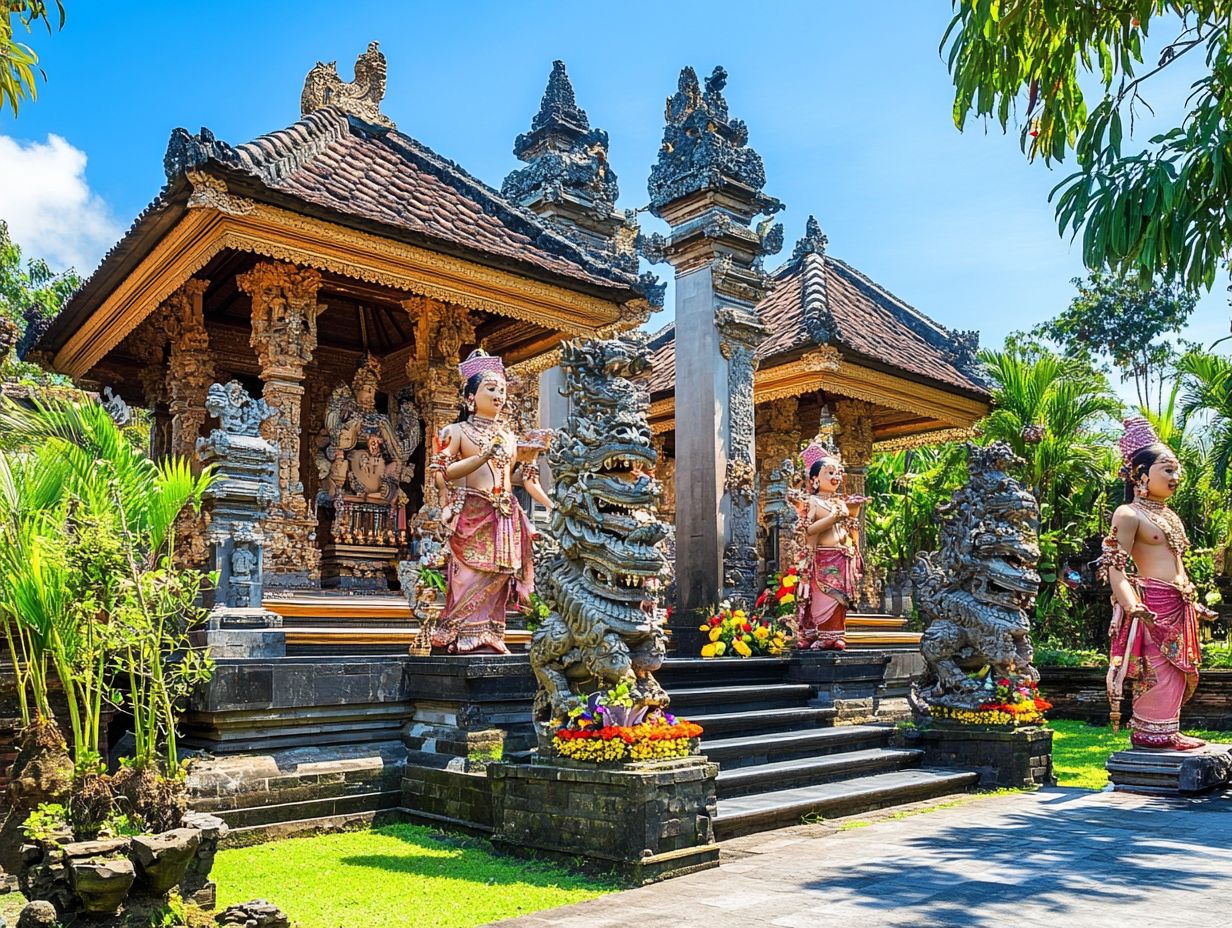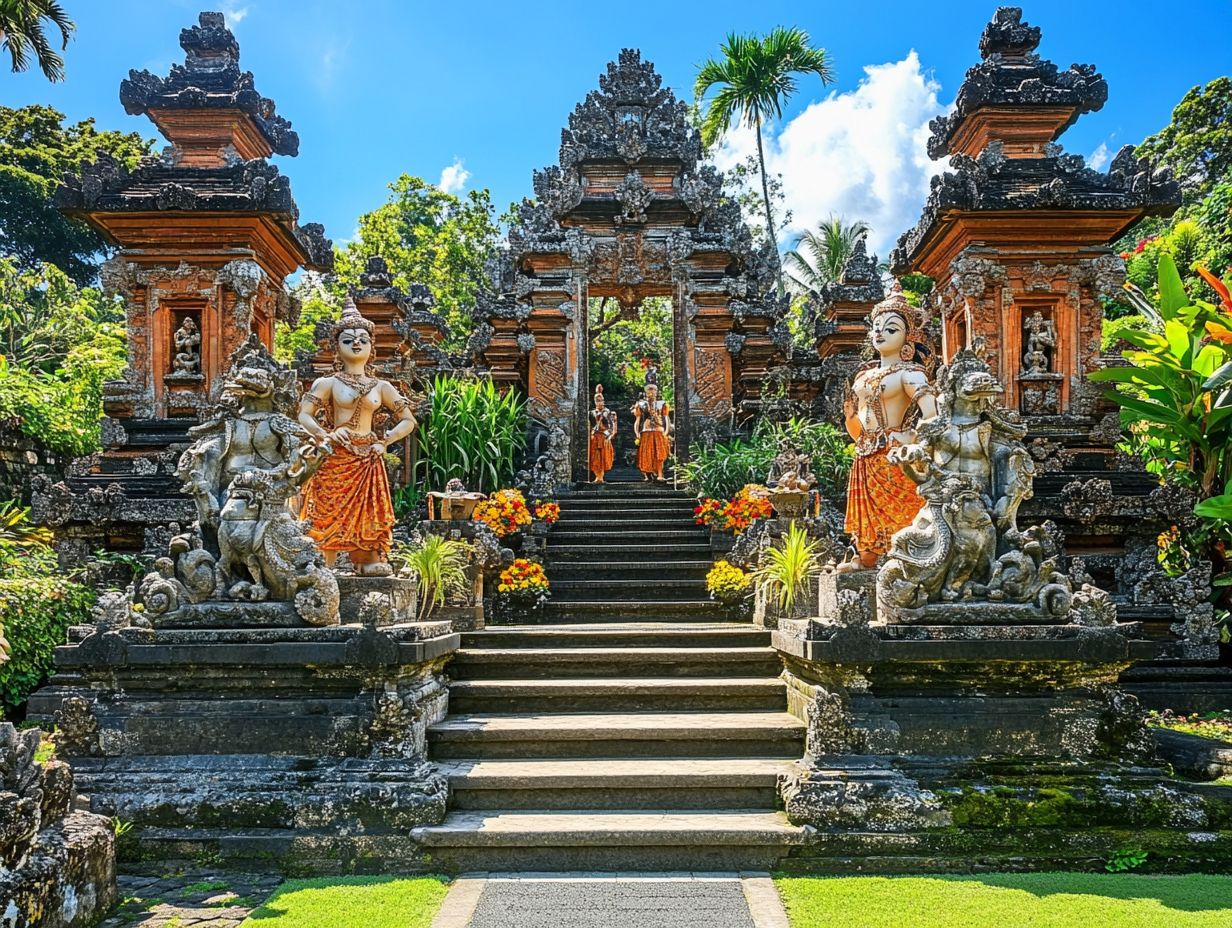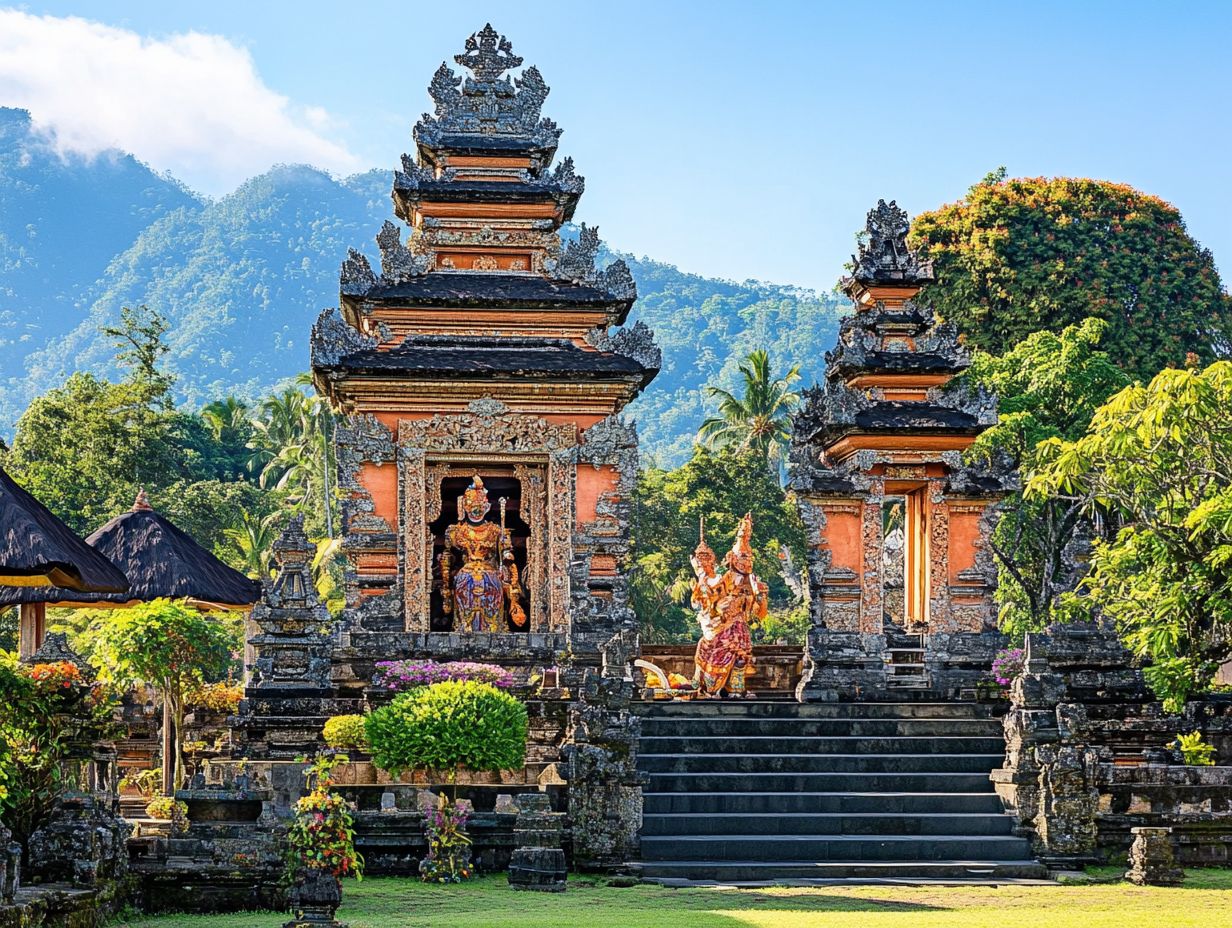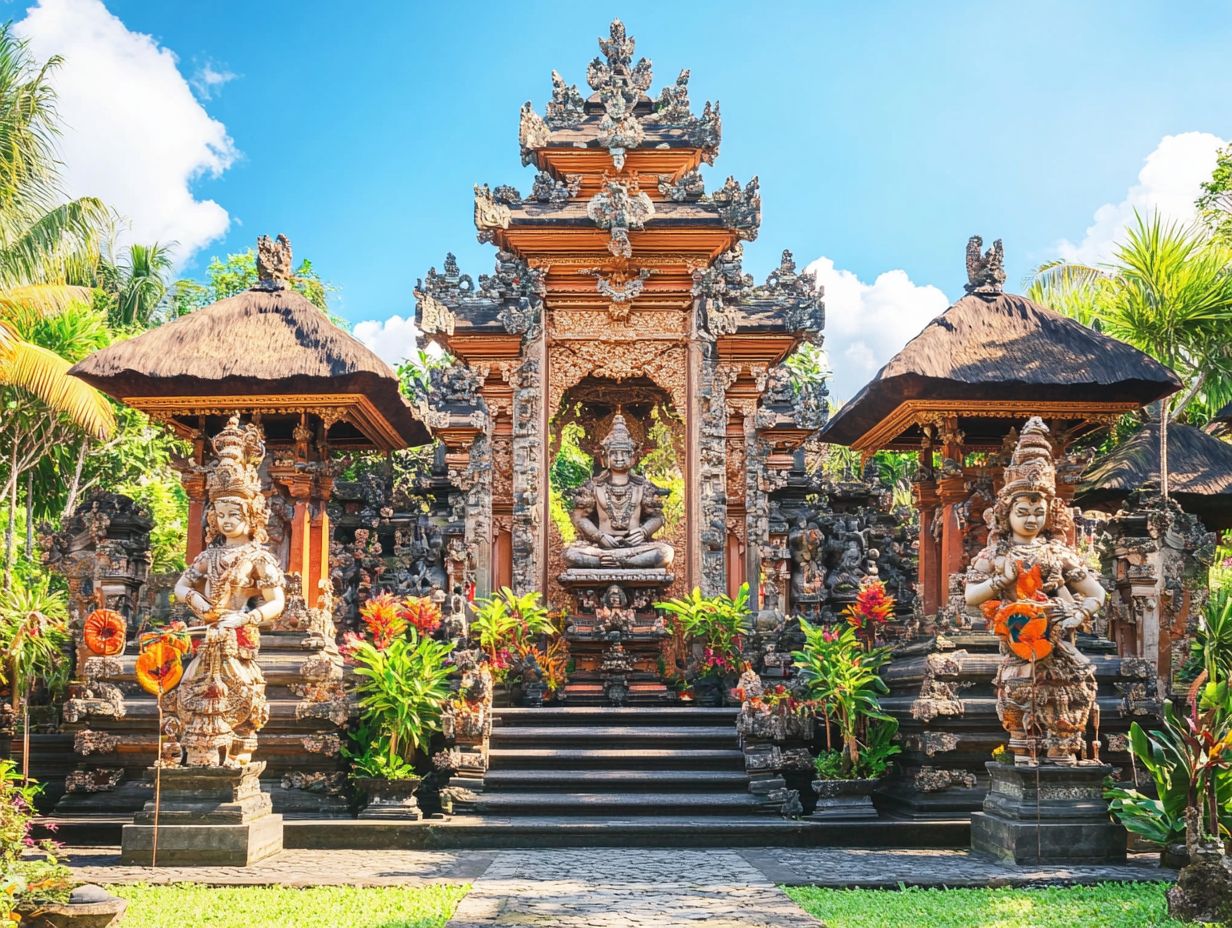How Did Hinduism Spread to Bali?
Hinduism, recognized as one of the oldest religions in the world, has intricately woven itself into the cultural fabric of Bali, Indonesia, profoundly shaping its traditions, arts, and daily life.
This article delves into the journey of Hinduism, tracing its origins and examining its significant influence in Bali. It uncovers the early factors that contributed to its arrival, explores the way it spread across the island through migration and trade, and discusses its enduring impact on contemporary Balinese culture.
Furthermore, it addresses the challenges that Hinduism faces in today s modern context and its current relevance within Balinese society amidst globalization. Readers are invited to explore the rich tapestry of Hinduism as it thrives in Bali, revealing the depth and complexity of its cultural significance.
What is Hinduism?

Hinduism stands as one of the world’s oldest religions, intricately interwoven into the social fabric of Indian civilization and profoundly influential in shaping the spiritual landscape of Southeast Asia, including Bali.
This complex belief system presents a rich tapestry of philosophies, rituals, and various practices that have evolved over millennia, reflecting the myriad ways in which humanity seeks to comprehend spirituality and the divine, often through religious syncretism and cultural adaptation.
Central to Hinduism are its sacred texts, including the esteemed Hindu epics, the Ramayana and the Mahabharata, which recount mythological narratives and impart spiritual teachings. The fusion of Brahmanism and animism, along with local adaptations, has cultivated a distinctive religious experience marked by a multitude of Hindu gods, deities, and practices.
History of Hinduism in Bali
The history of Hinduism in Bali unfolds as a remarkable narrative characterized by cultural exchange, primarily between Indian traders and the indigenous populations. This interaction was facilitated through ancient maritime routes that linked the Indian subcontinent with various regions across Southeast Asia, including Bali.
Such historical migrations played a pivotal role in establishing Hinduism as a prominent religion in Bali, profoundly influencing its cultural identity and social structure. The seamless integration of Hindu beliefs with local traditions, rituals, and practices culminated in the emergence of a distinctive form known as Balinese Hinduism.
This unique variant encompasses a vibrant array of rituals, ceremonies, and community values that continue to flourish in contemporary Balinese society.
Early Influences
The early influences of Hinduism in Bali can be traced back to the arrival of Indian civilization, which introduced a wealth of knowledge, cultural practices, and spiritual concepts through extensive maritime routes that facilitated cultural diffusion and religious syncretism across Southeast Asia.
These Indian traders engaged in more than mere commerce; alongside spices and textiles, they exchanged transformative ideas that led to the integration of various religious rituals and artistic expressions into Balinese culture. Influential texts such as the Ramayana and Mahabharata became entwined with local storytelling traditions, enriching the spiritual landscape of the island and reflecting the profound cultural exchange.
The significance of rituals within Balinese society is paramount; daily offerings and ceremonies are a testament to a harmonious blend of Hindu beliefs and animistic practices that honor both deities and ancestral spirits, illustrating the rich tapestry of cultural assimilation and religious beliefs.
Consequently, the impact of these early exchanges has become inextricably woven into the fabric of Bali’s identity, crafting a unique cultural tapestry that continues to thrive in contemporary times.
Arrival of Hinduism in Bali
The arrival of Hinduism in Bali represents a pivotal moment in the island’s history, initiated by Indian traders who engaged in cultural exchanges and established trade relationships that facilitated the transfer of spiritual beliefs and practices. These traders brought not only valuable goods but also a rich tapestry of ideas, customs, and rituals that began to intertwine with the existing local traditions and Hindu philosophy.
As the islanders interacted with these foreign merchants, they absorbed the philosophical concepts of Hinduism, gradually integrating them into their cultural framework. This fusion of beliefs gave rise to Balinese Hinduism, distinguished by its unique rituals, arts, and communal ceremonies that reflect both Indian influences and the distinctive essence of Bali itself, showcasing the impact of religious syncretism and cultural adaptation.
This captivating blending of cultures ultimately laid the groundwork for a spiritual heritage that remains vibrant and influential in Balinese life to this day, reflecting the historical significance and lasting impact of these early cultural exchanges.
Spread of Hinduism in Bali
The spread of Hinduism in Bali unfolded gradually, characterized by the integration of Hindu rituals and the construction of temples, alongside the active involvement of the community in spiritual practices. This evolution intricately wove together the island’s local beliefs and customs, including indigenous beliefs and traditions.
The origins of this transformation can be traced to the arrival of Indian traders and sailors, who not only introduced trade goods but also their rich cultural and religious ideologies. As Bali embraced these new concepts, the establishment of elaborate Hindu temples became a defining feature of the island’s landscape, serving as sanctuaries for communal worship.
Over time, the local population adapted various Hindu rituals, seamlessly blending them with indigenous traditions and customs. This fusion resulted in a vibrant tapestry of festivals that beautifully reflects the island’s rich heritage.
Through celebrations such as Nyepi and Galungan, the Balinese express their spirituality while honoring their ancestral roots, solidifying Hinduism as an integral part of their daily lives and cultural identity. These festivals, alongside other Hindu festivals, exemplify the deep connection between culture and religion in Bali.
Impact of Hinduism on Balinese Culture
The influence of Hinduism on Balinese culture is profound, permeating numerous facets of daily life, including religious practices, community rituals, art, architecture, and the overarching social framework of Balinese society. The impact of Hindu rituals and traditions is evident in the cultural heritage and social customs of the island.
This religion has significantly shaped how the Balinese express their spirituality, manifesting in vibrant festivals, elaborate temples, and intricate rituals that embody their beliefs and devotion to their deities. The influence of Hindu gods and sacred texts is deeply embedded in their daily practices.
The seamless integration of Hindu principles into local traditions has enriched Bali’s cultural identity, resulting in a unique amalgamation of faith and everyday existence that continues to be cherished and celebrated by its people.
Religion

Religion holds a pivotal position in the lives of the Balinese, with Hinduism as the predominant belief system that directs their rituals, the worship of deities, and the guidance offered by the priesthood and spiritual leaders within the community.
This vibrant faith is intricately woven into the cultural identity of the island, influencing everything from art and architecture to daily practices and festivals. Rituals transcend mere formalities; they encapsulate the very essence of Balinese life, reinforcing social bonds and fostering a profound connection to the divine.
The importance of offerings, ceremonies, and communal gatherings illustrates the harmonious interplay between spiritual devotion and social unity, culminating in a rich tapestry of religious life. Each community’s unique interpretation of Hinduism fortifies the collective spirit, drawing individuals closer not only to the deities they venerate but also to the traditions that define their identity.
Arts and Architecture
The arts and architecture of Bali are profoundly shaped by Hinduism, with temples standing as iconic symbols of spiritual devotion and cultural heritage. These sacred structures showcase elaborate designs and intricate religious art that vividly narrate the mythology of Hindu deities, reflecting the island’s rich cultural history and religious identity.
Such sacred spaces transcend mere architectural wonders; they resonate deeply with the community’s spiritual beliefs, serving as focal points for rituals and celebrations. The island’s artistic expressions, ranging from traditional dance performances to vibrant paintings, are intricately woven with Hindu narratives, reflecting themes of love, struggle, and divine intervention. These artistic traditions are vital to cultural preservation and the passing down of oral traditions.
Every temple, adorned with stunning carvings and sculptures, tells a unique story. The performances, often accompanied by the enchanting sounds of gamelan music, breathe life into these tales, enveloping audiences in a rich tapestry of spirituality and local culture.
This harmonious fusion of spirituality and artistic expression cultivates a distinctive cultural identity that continues to thrive and evolve, enhancing Bali’s mystique as a destination revered for its devotion and creativity. The influence of Hindu art is evident in the island’s extensive cultural practices and social customs.
Traditions and Customs
Traditions and customs in Bali are profoundly intertwined with Hinduism, shaping the very fabric of community life. From the intricacies of family lineage to the execution of sacred rituals and the exuberant celebration of festivals, these cultural practices unite the community in a shared expression of devotion. The impact of historical migrations and intercultural dialogue is evident in the island’s rich array of syncretic practices.
These traditions reveal themselves in myriad forms, particularly through the elaborate ceremonies that commemorate significant life events such as birth, marriage, and death. During these moments, families gather to honor their ancestors while seeking blessings for the future. The influence of cultural assimilation and religious reforms can be seen in these diverse practices.
Communal festivals like Galungan and Kuningan not only showcase the rich tapestry of Balinese spirituality but also strengthen social ties, bringing together families and neighbors in joyful celebration of their cultural heritage. The vibrant colors and resonant sounds of these festivities serve as vivid reminders of the island’s unique identity, where each ritual performed and festival celebrated plays an essential role in preserving the essence of what it means to be Balinese.
Reasons for the Spread of Hinduism in Bali
The proliferation of Hinduism in Bali can be attributed to a multitude of factors. These include the island’s geographical proximity to India, the dynamic engagement in trade and commerce, and the rich cultural influences that traversed ancient maritime routes, linking the region to the broader Indian civilization.
Geographical Proximity to India
Geographical proximity to India was instrumental in the early establishment and proliferation of Hinduism in Bali, fostering a rich cultural exchange and facilitating the movement of people, ideas, and religious practices throughout the region. This close physical distance allowed merchants, scholars, and spiritual leaders to navigate the seas, bringing with them not merely goods but also the intricate tapestry of Hindu beliefs and traditions.
As these influences took root in Bali, they seamlessly intertwined with the island’s indigenous customs, giving rise to a distinctive form of Hinduism that continues to thrive today. Rituals and ceremonies evolved, reflecting a synthesis of Indian philosophies and local practices, evident in the elaborate temple architecture and the deep reverence for ancestral spirits that permeates Balinese life.
Thus, the geographic advantages of this tropical paradise have indelibly shaped Balinese Hindu culture, establishing it as a significant hub of spiritual and artistic expression.
Trade and Commerce
Trade and commerce played a pivotal role in the introduction of Hinduism to Bali, with Indian traders serving as instrumental figures in the dissemination of cultural practices. These merchants facilitated not only the exchange of goods but also the transfer of spiritual beliefs and customs.
As these traders navigated the seas, they transported more than just spices and textiles; they carried with them a rich tapestry of religious narratives, rituals, and practices that began to resonate with the local populace. Intrigued by these novel spiritual concepts, the Balinese people gradually integrated Hindu beliefs into their existing traditions, giving rise to a unique cultural synthesis.
Temples began to rise, adorned with intricate carvings that depicted Hindu deities, while local festivals started incorporating elements of Indian spirituality. This cross-cultural engagement fostered a dynamic exchange, enriching the identities of both merchants and local communities. The result was a vibrant and diverse religious landscape that continues to flourish in Bali today.
Political and Cultural Influences

Political and cultural influences played a pivotal role in the dissemination of Hinduism in Bali, where the seamless integration of Hindu practices into local governance structures solidified its significance within the island’s societal framework.
This unique synergy between governance and spirituality allowed local leaders to embrace Hindu norms, deftly interlacing them into the daily lives of the Balinese people. The ruling elites, often regarded as the guardians of political authority and spiritual insight, championed Hindu rituals and festivals, which in turn fostered a rich tapestry of cultural expressions reflecting these beliefs.
Temples emerged as vibrant community centers, nurturing a sense of unity among the Balinese while simultaneously reinforcing the legitimacy of the ruling class. The flourishing of artistic forms, such as dance and music, further propagated Hindu ideals, embedding them deeply into the island’s identity and resonating through generations.
Consequently, Hinduism transcended the boundaries of mere religious practice; it became an essential element of governance and cultural identity, profoundly enriching the social landscape of Bali.
Challenges and Controversies
The introduction and establishment of Hinduism in Bali have encountered a myriad of challenges and controversies, particularly regarding its interplay with indigenous beliefs and the evolving interpretations of the religion in contemporary society.
Conflicts with Indigenous Beliefs
Conflicts with indigenous beliefs emerged as Hinduism took root in Bali, leading to a nuanced process of syncretism that facilitated the coexistence and adaptation of local traditions alongside Hindu practices.
This dynamic interplay between the two belief systems manifested in various forms, from rituals to festivals, showcasing how the local populace seamlessly integrated Hindu deities and philosophies into their existing spiritual frameworks. Rather than perceiving these differences as divisive, many Balinese individuals embraced a blended spirituality that honored their ancestral customs while concurrently incorporating Hindu elements.
As a result, a rich tapestry of beliefs emerged, with offerings to the gods uniquely reflecting both the vibrant traditions of indigenous cultures and the influences of Hindu rituals. Thus, the ongoing dialogue between these spiritual practices has fostered a distinctive cultural identity in Bali, characterized by resilience and adaptability.
Modern Interpretations of Hinduism in Bali
Modern interpretations of Hinduism in Bali have surfaced as a response to globalization, fostering a dynamic evolution of spiritual practices dedicated to preserving cultural heritage while adapting to contemporary influences.
This evolving landscape showcases an intriguing interplay between tradition and modernity, where local practitioners increasingly weave global ideas, technologies, and artistic expressions into their rituals and community life. Balinese Hinduism, shaped by external practices, has given rise to new forms of worship and celebration that resonate with both the island’s ancient customs and the contemporary zeitgeist of today s interconnected world.
As globalization permeates everyday life, the community faces the challenge of upholding the essence of their beliefs and rituals, ensuring that while they embrace change, they also protect the rich tapestry of their spiritual identity.
Current State of Hinduism in Bali
The current state of Hinduism in Bali showcases a vibrant and dynamic practice, where the religion continues to play a central role in the daily lives of the population.
It profoundly shapes their demographics and religious practices, while also exerting a significant influence on the island’s tourism sector.
Population and Demographics
The population and demographics of Bali are profoundly shaped by Hinduism, with the vast majority of Balinese individuals identifying with this religion, which intricately influences their cultural practices and community life. This deep-rooted connection to Hinduism dictates not only the daily rituals and vibrant festivals that punctuate the calendar year but also cultivates a strong sense of unity within the community.
In Bali, the pervasive influence of religion can be observed in various facets of daily life, from the intricate offerings meticulously prepared for the deities to the elaborate ceremonies that commemorate significant life events. The adherence of the Balinese people to Hindu beliefs fosters social cohesion, with numerous gatherings centered around religious observances that reinforce familial and communal bonds.
Moreover, the teachings of Hinduism advocate values such as harmony and reverence for nature, principles that are intricately woven into the very fabric of Balinese society. These values significantly influence the way individuals interact with one another and engage with their environment, enriching the cultural tapestry of the island.
Religious Practices and Festivals

Religious practices and festivals in Bali serve as vibrant manifestations of Hinduism, distinguished by intricate rituals, active community engagement, and the thoughtful presentation of offerings that pay homage to the deities and the sacred.
These celebrations are deeply woven into the fabric of daily life for the Balinese people, reflecting a profound spirituality and a steadfast commitment to maintaining harmony with the universe. The atmosphere bursts with color, music, and dance as families unite to craft elaborate offerings, often composed of flowers, rice, and coconut leaves, symbolizing their gratitude and devotion.
Each festival, whether it be the exuberant Galungan or the contemplative Nyepi, functions as a communal bond that reinforces traditions passed down through generations. This dynamic involvement not only fortifies community connections but also serves as a poignant reminder of their rich cultural heritage, ensuring that the essence of Balinese Hinduism continues to flourish.
Impact on Tourism
The influence of Hinduism on tourism in Bali, Indonesia is profoundly significant, drawing millions of visitors each year who are eager to immerse themselves in the island’s rich cultural heritage and spiritual experiences. Known as the Island of the Gods, Bali presents a captivating blend of breathtaking landscapes and vibrant traditions that resonate with its deep-rooted beliefs and rituals.
Tourists are naturally drawn to iconic temples such as Uluwatu and Tanah Lot, where stunning ocean vistas enhance the intricate architecture that narrates tales of devotion, mythology, and historical significance. Spiritual rituals, including Hindu ceremonies and lively festivals, invite guests to engage with the island s deeply spiritual culture, fostering meaningful connections through offerings and traditional ceremonies.
Bali s cultural heritage, infused with its Hindu customs, not only enriches the tourism experience but also promotes respect and understanding among diverse cultures, making it a truly unique destination for travelers from around the globe. The influence of ancient Indian civilization and maritime trade routes has left a lasting impact on the island’s culture and religious practices.
Frequently Asked Questions
What is the history of Hinduism in Bali?
Hinduism spread to Bali from mainland India around the 1st century CE through trade and cultural exchange, particularly via maritime trade routes that facilitated the movement of people and ideas.
Did Hinduism completely replace the local beliefs in Bali?
No, the Balinese people integrated Hinduism with their existing spiritual and indigenous beliefs, resulting in a unique form of Hinduism known as “Balinese Hinduism”, which incorporates elements of animism and local traditions.
What are some key elements of Balinese Hinduism?
Offerings to deities, temple ceremonies, ancestor worship, and rituals and ceremonies are some important practices in Balinese Hinduism. These practices reflect the community’s deep spiritual teachings and devotion.
How did Hinduism become the dominant religion in Bali?
Through the influence of Hindu kingdoms in Java and Sumatra and the migration of Javanese people, Hinduism gradually spread and became the dominant religion in Bali.
What impact did Hinduism have on Balinese culture?
Hinduism heavily influenced Balinese art, literature, dance, music, and cuisine, resulting in a rich and diverse cultural heritage. This influence extended to social customs, religious architecture, and the island’s overall cultural identity.
Is Hinduism still practiced in Bali today?
Yes, Hinduism is still the main religion in Bali and is deeply ingrained in the daily lives and traditions of the Balinese people, including their spiritual practices, religious tolerance, and cultural preservation efforts.
